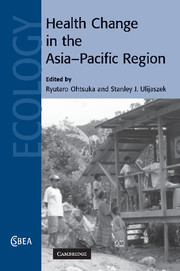Book contents
- Frontmatter
- Contents
- List of contributors
- Acknowledgements
- 1 Health change in the Asia-Pacific region: disparate end-points?
- 2 Interactions of nutrition, genetics and infectious disease in the Pacific: implications for prehistoric migrations
- 3 Biocultural adaptation and population connectedness in the Asia-Pacific region
- 4 Changing nutritional health in South East Asia
- 5 Obesity and nutritional health in Hong Kong Chinese people
- 6 Modernization, nutritional adaptability and health in Papua New Guinea Highlanders and Solomon Islanders
- 7 Tongan obesity: causes and consequences
- 8 Nutrition and health in modernizing Samoans: temporal trends and adaptive perspectives
- 9 Health patterns of Pacific Islanders and Asians in the United States
- 10 Impacts of modernization and transnationalism on nutritional health of Cook Islanders
- 11 Mortality decline in the Pacific: economic development and other explanations
- 12 Health changes in Papua New Guinea: from adaptation to double jeopardy?
- Index
- References
6 - Modernization, nutritional adaptability and health in Papua New Guinea Highlanders and Solomon Islanders
Published online by Cambridge University Press: 15 September 2009
- Frontmatter
- Contents
- List of contributors
- Acknowledgements
- 1 Health change in the Asia-Pacific region: disparate end-points?
- 2 Interactions of nutrition, genetics and infectious disease in the Pacific: implications for prehistoric migrations
- 3 Biocultural adaptation and population connectedness in the Asia-Pacific region
- 4 Changing nutritional health in South East Asia
- 5 Obesity and nutritional health in Hong Kong Chinese people
- 6 Modernization, nutritional adaptability and health in Papua New Guinea Highlanders and Solomon Islanders
- 7 Tongan obesity: causes and consequences
- 8 Nutrition and health in modernizing Samoans: temporal trends and adaptive perspectives
- 9 Health patterns of Pacific Islanders and Asians in the United States
- 10 Impacts of modernization and transnationalism on nutritional health of Cook Islanders
- 11 Mortality decline in the Pacific: economic development and other explanations
- 12 Health changes in Papua New Guinea: from adaptation to double jeopardy?
- Index
- References
Summary
Introduction
Economic modernization is global in outreach, and the countries in the South Pacific are not exempt. The Melanesian populations of Papua New Guinea (PNG) and the Solomon Islands are experiencing increasing involvement in the cash economy, and associated changes in diet, which now includes more purchased foods. Modernization and urbanization have also led to sedentary lifestyles, due to increased mechanization of work and a shift from subsistence activities (including traditional agriculture, fishing, hunting and gathering) to paid jobs. Dietary changes, such as increases in fat and sugar intakes and decreased fibre intake, together with reduced physical activity, have contributed to the increasing prevalence of obesity and degenerative diseases, such as type 2 diabetes and cardiovascular diseases.
Melanesians are broadly divided into two language groups – Austronesian (AN) and non-Austronesian (NAN). The AN-language speakers within PNG are part of a much larger AN-language family, which stretches from South East Asia to Hawaii and from Micronesia to New Zealand (Foley 1992). By contrast, NAN-language speakers are found predominantly on the mainland of PNG and have a much longer history than AN-language speakers (Foley 1992). It has been argued that the two groups differ genetically, this being reflected in their differing susceptibilities to type 2 diabetes and cardiovascular diseases (being less prevalent in NAN- than in AN-language speakers) (King 1992; Hodge et al. 1996).
- Type
- Chapter
- Information
- Health Change in the Asia-Pacific Region , pp. 101 - 126Publisher: Cambridge University PressPrint publication year: 2007
References
- 6
- Cited by



